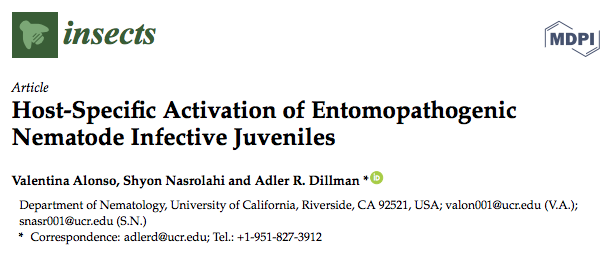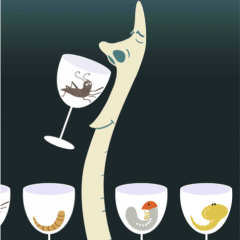 We have characterized a new species of entomopathogenic nematode (EPN). This EPN was isolated from Thailand and falls within the Longicaudatum clade, being closely related to Steinernema hermaphroditum. The nematode was named after Dr. Byron Adams, who was Dr. Dillman’s undergraduate mentor and who introduced Dr. Dillman to EPNs in 2003. Steinernema adamsi is the newest EPN to be described and has much to teach us about how nematodes parasitize insects. It may also be useful in biological control. A UCR press release has additional information.
We have characterized a new species of entomopathogenic nematode (EPN). This EPN was isolated from Thailand and falls within the Longicaudatum clade, being closely related to Steinernema hermaphroditum. The nematode was named after Dr. Byron Adams, who was Dr. Dillman’s undergraduate mentor and who introduced Dr. Dillman to EPNs in 2003. Steinernema adamsi is the newest EPN to be described and has much to teach us about how nematodes parasitize insects. It may also be useful in biological control. A UCR press release has additional information.
Tag: Entomopathogenic nematodes
Microbiome and Efficacy of Phasmarhabditis to Control Slugs and Snails
Our lab has recently published three studies on the slug-parasitic nematode Phasmarhabditis californica. One study on the native microbiome of these nematodes and two studies on the efficacy of these nematodes against different snail pests; Succinea snails and Theba snails. Most of the work the lab has done on Phasmarhabditis nematodes was driven by Dr. Jake Schurkman, who recently graduated and Dr. Irma Tandingan De Ley, who recently retired. During his time in the lab, Jake was an author on 8 papers, most of which were focused on interactions between gastropods and parasitic nematodes. The species that he worked on, P. california, was discovered by Irma and several colleagues. That nematode is now being sold as a commercial biological control agent to kill slugs. At this point however, it is only available in Europe, not the US. Hopefully this becomes available in the US in the near future.
Proof of Concept Funding
We are excited to learn that our work on nematode-derived toxins will be supported by proof of concept funding by UCR. “We look for projects that promise to solve one or more urgent problems. We help those researchers with a little seed funding to move their work closer to commercialization,” explained Mark Leibowitz, interim director of UCR’s Entrepreneurial Proof of Concept and Innovation Center, or EPIC.”
“Adler Dillman, an assistant professor of nematology, received $30,000 to identify the proteins some nematodes secrete when they infect an insect and kill it. Dillman plans to use the toxin in a pesticide, or genetically modify crops to produce the protein and become naturally insect-resistant. Most corn and cotton in the U.S., for example, has been genetically modified to produce a protein called BT toxin, originally found in a type of bacteria. But insects are starting to resist BT toxin, and the nematode-derived toxin could serve as a supplement or alternative.”
https://news.ucr.edu/articles/2019/01/10/awards-help-faculty-commercialize-inventions
Sand cricket resistance to EPN infection

Congratulations to Sudarshan, Dihong, Kathleen, Lauren, and Carter on the recent publication of their work on sand crickets. We are excited that this paper includes 3 undergraduate students as co-authors. We are eager to continue our research on S. scapterisci and its relationship with its bacterial symbiont X. innexi. This specialist parasite is becoming more interesting the more we learn about it.
New paper published by undergraduate researchers

Congratulations to Valentina and Shyon on the publication of their work on EPN activation. This research effort was led by Valentina and is the culmination of research that she’s been doing in the lab since January 2017. Shyon joined the project in January of this year and was able to make a significant contribution to this project. We support helping undergraduates publish their research.

